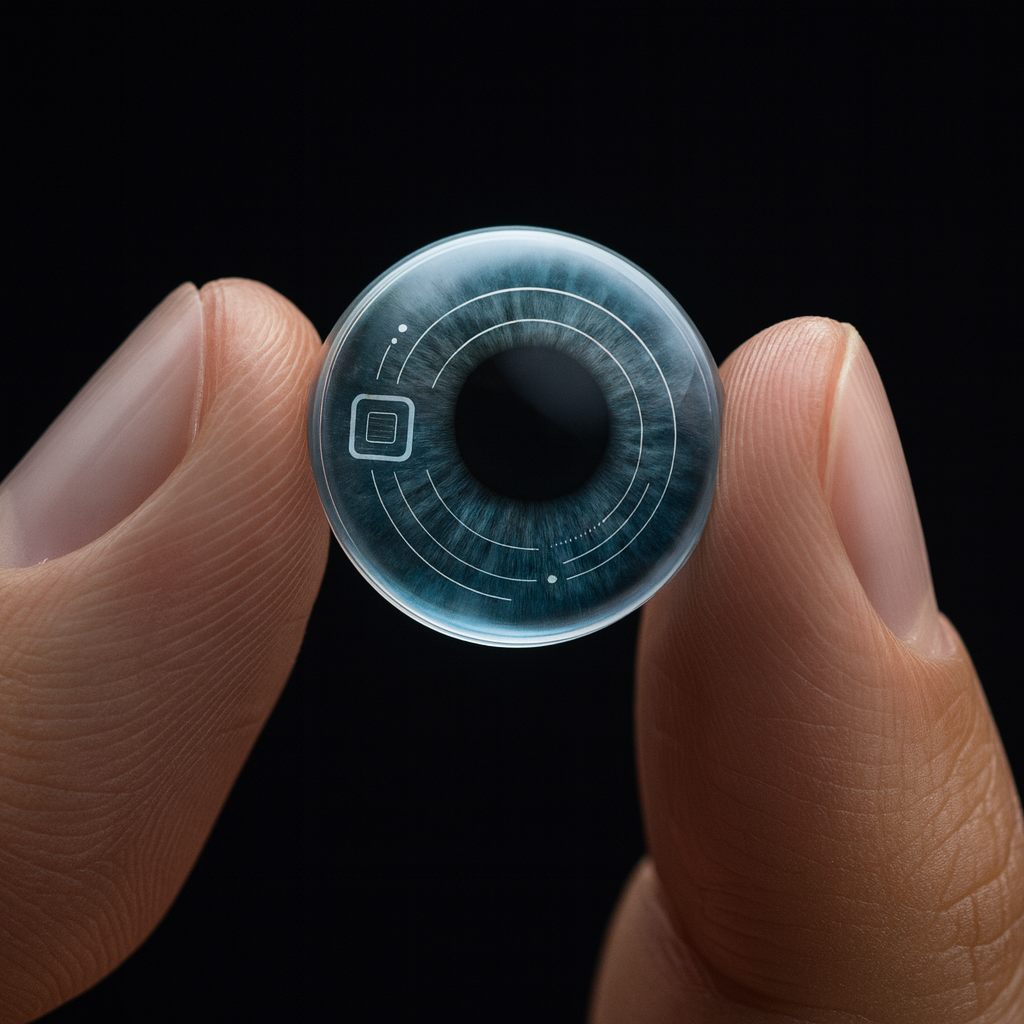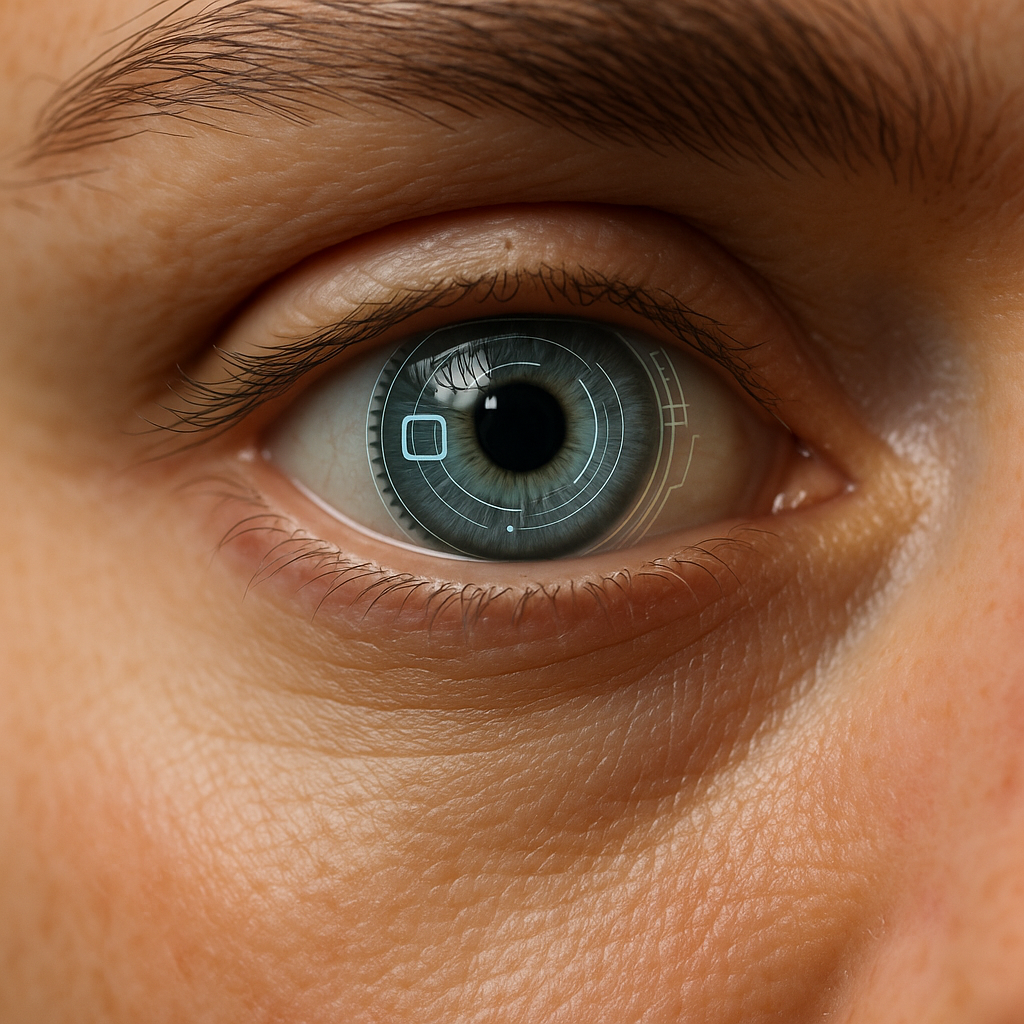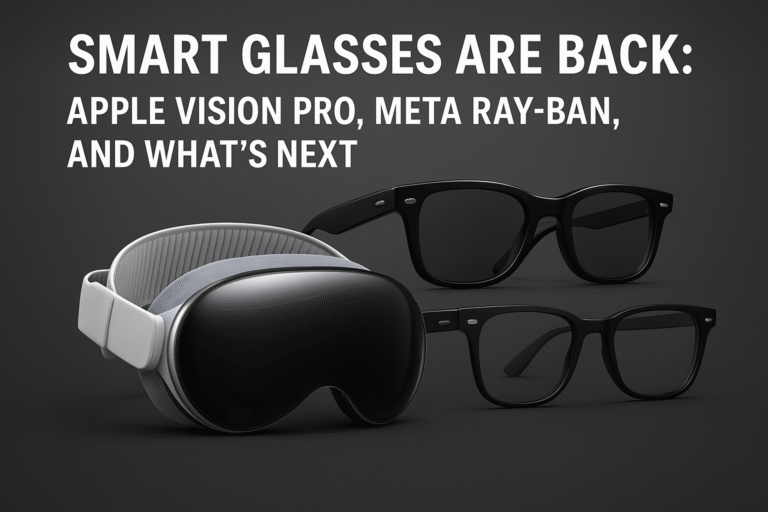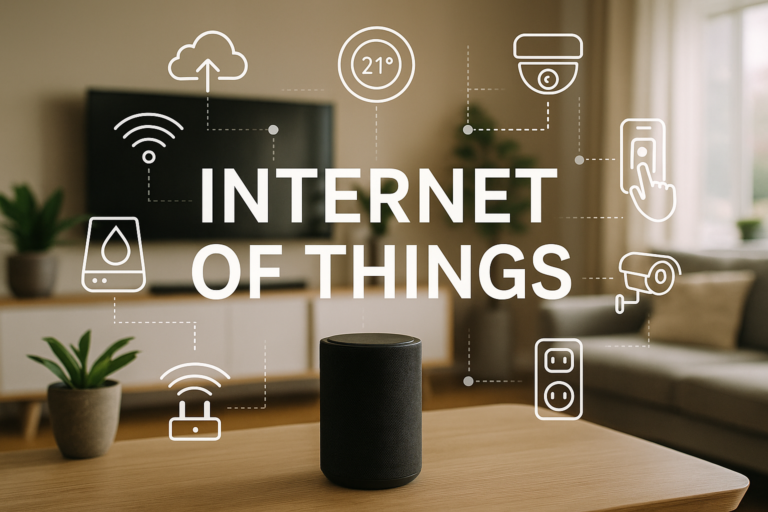-
1
The Next Frontier of Wearable Tech
- 1.1 What Are Smart Contact Lenses?
- 1.2 Types of Smart Contact Lenses
- 1.3 Key Players and Startups Driving Innovation
- 1.4 Smart Glasses vs Smart Contact Lenses
- 1.5 Real-World Applications
- 1.6 Challenges and Limitations
- 1.7 The Future: When Will Smart Contact Lenses Become Mainstream?
- 1.8 📊 Smart Glasses vs Smart Contact Lenses
- 1.9 From Sci-Fi to Reality
- 1.10 FAQ
The Next Frontier of Wearable Tech
Imagine a future where you no longer need to pull out your smartphone or wear bulky AR glasses to stay connected. Instead, a tiny, transparent lens resting on your eye could project digital information, monitor your health, and even enhance your vision. This isn’t a scene from a sci-fi movie—it’s the promise of smart contact lenses, a technology at the intersection of biotechnology, nanotechnology, and digital innovation.
Over the last decade, we’ve seen wearables evolve from fitness trackers to sophisticated smartwatches and high-tech glasses like Apple Vision Pro or Meta’s Ray-Ban Stories. Each step brought us closer to seamless human-computer integration. But while glasses remain visible and sometimes socially awkward, smart contact lenses represent the ultimate invisible interface—merging augmented reality (AR), healthcare monitoring, and superhuman vision capabilities directly into your eyes.
Today, these lenses are still in their experimental phase, with prototypes from startups like Mojo Vision and Xpanceo showing glimpses of what’s possible. Researchers are exploring everything from drug-releasing medical lenses to infrared-enabled “super vision”. Billions in funding, combined with breakthroughs in miniaturized electronics and bio-compatible materials, are rapidly accelerating this field. In other words, the age of smart contact lenses is no longer a distant dream—it’s a technological revolution already in motion.
What Are Smart Contact Lenses?
At their core, smart contact lenses are advanced optical devices that look almost identical to traditional lenses but hide an array of miniaturized electronics inside. Using breakthroughs in microchips, sensors, and ultra-thin displays, these lenses can do far more than correct vision—they’re designed to become a digital interface for the human eye.
Unlike regular lenses, smart contacts can integrate:
- Micro-displays capable of projecting text, images, or navigation cues directly into your field of vision.
- Biometric sensors that measure things like intraocular pressure, tear fluid composition, or glucose levels—potentially useful for patients with diabetes or glaucoma.
- Wireless antennas that communicate data to external devices, from smartphones to medical dashboards.
- Energy-harvesting systems that may one day power the lens using body heat, motion, or even solar light.
This combination of features makes them a fusion of healthcare, augmented reality, and biotechnology. Some designs focus purely on medical applications, such as lenses that deliver drugs to the eye or track diseases in real time. Others, like those from Mojo Vision or Xpanceo, push toward augmented reality overlays, allowing users to read notifications, follow maps, or enhance vision without bulky headsets.
What truly sets smart contact lenses apart from Smart Glasses is their invisibility and seamless integration. You don’t have to wear a device on your face or carry an external screen—the technology moves naturally with your eyes. In theory, this could make them the most intuitive wearable ever created: a piece of tech that becomes an extension of your biology rather than a gadget you put on.
Types of Smart Contact Lenses

Smart contact lenses are not a one-size-fits-all technology. Different research teams and companies are developing them for specific purposes—from healthcare and diagnostics to futuristic augmented reality. Here’s a closer look at the main categories:
Augmented Reality (AR) Lenses
Perhaps the most futuristic type, AR lenses are designed to project digital overlays directly into your vision. Imagine looking at a street and instantly seeing navigation arrows, or checking a text message without touching your phone.
- Mojo Vision is the pioneer here, creating a prototype with a micro-LED display smaller than a grain of sand, capable of displaying text and simple graphics.
- These displays move with your eyes, meaning the information always stays centered in your vision.
- Future AR lenses could replace bulky headsets like Apple Vision Pro, offering the same functionality in a discreet, wearable format.
The potential goes beyond convenience—surgeons could see patient data during operations, engineers could visualize schematics, and athletes could receive real-time performance stats without breaking focus.
Medical & Health Monitoring Lenses
One of the most promising areas is healthcare. Since tears contain biomarkers of diseases, smart contact lenses can act as non-invasive biosensors.
- Researchers are developing lenses that measure intraocular pressure to monitor glaucoma, a condition that can lead to blindness if untreated.
- Some prototypes can analyze tear glucose levels, offering a new way for diabetics to track blood sugar without finger pricks.
- Others are experimenting with RFID-based systems that track eye movement and neurological health, potentially aiding early diagnosis of conditions like Parkinson’s or Alzheimer’s.
These lenses transform the eye into a window of health data, offering continuous monitoring that could revolutionize preventive medicine.
Vision Enhancement (Infrared, Color Perception)
Smart lenses aren’t limited to displaying or measuring—they can also expand human vision.
- In 2023, a Chinese research team developed lenses that allow users to see infrared light, effectively granting “night vision” capabilities.
- Other designs work on enhancing color perception, particularly for people with color blindness. By filtering or adjusting wavelengths, these lenses could help users perceive a broader range of colors.
- Future iterations may even include zoom functions, allowing wearers to switch between normal and magnified vision.
This type of lens pushes beyond healthcare into human augmentation, offering capabilities that were once reserved for science fiction or military tech.
Drug-Releasing Contact Lenses
Not all smart lenses are digital. Some focus on pharmaceutical delivery, using advanced polymers and coatings to slowly release medication into the eye.
- Johnson & Johnson’s ACUVUE Therapeutic Lenses are FDA-approved and can release antihistamines for up to 12 hours, easing allergy symptoms.
- Experimental lenses are being designed to treat glaucoma, dry eye syndrome, and corneal injuries, ensuring patients receive consistent doses without relying on eye drops.
- By delivering drugs directly where they’re needed, these lenses increase treatment effectiveness and improve patient compliance.
This category highlights how smart lenses aren’t just about technology—they’re also about transforming eye care.
In short:
- AR lenses → futuristic overlays and digital assistants.
- Medical lenses → health diagnostics and disease monitoring.
- Vision enhancement → superhuman sight (infrared, zoom, color correction).
- Drug-releasing lenses → advanced treatment for eye conditions.
Key Players and Startups Driving Innovation
While the concept of smart contact lenses feels futuristic, dozens of companies and research labs are already racing to make it reality. Some focus on augmented reality (AR), others on medical applications, and a few are trying to combine both. Let’s break down the main innovators in this space.
Mojo Vision (USA) – The AR Pioneer
Mojo Vision has become almost synonymous with smart contact lenses. Based in California, the company developed a prototype featuring the world’s smallest and densest micro-LED display, measuring just 0.5 millimeters in diameter.
- This display can project green monochrome text and graphics directly into the wearer’s vision.
- The lens also includes eye-tracking sensors, ensuring the display stays aligned with your gaze.
- Mojo originally targeted consumer AR but pivoted toward medical and enterprise markets after funding challenges.
Although still experimental, Mojo Vision remains one of the most advanced AR lens developers and could be the first to bring them to professional use.
Xpanceo (Dubai) – The Futurist Challenger
Xpanceo, a Dubai-based startup, made headlines in 2025 by raising $250 million in funding. Its ambition? To create the ultimate all-in-one smart lens.
Their vision includes:
- Augmented reality overlays for digital information.
- Night vision and infrared capability, inspired by military applications.
- Optical zoom functions, allowing users to switch between normal and magnified vision.
- Health monitoring sensors embedded directly into the lens.
Unlike Mojo Vision, which focuses on step-by-step progress, Xpanceo aims to leapfrog into the future with a multifunctional device. They expect professional use cases by 2027, with a potential consumer rollout in the early 2030s.
Johnson & Johnson (USA) – The Medical Innovator
While startups chase futuristic AR, Johnson & Johnson is taking a practical healthcare-first approach. Their ACUVUE Therapeutic Contact Lens, approved by the FDA, is the first drug-releasing contact lens on the market.
- It delivers a consistent dose of antihistamine (ketotifen) to relieve eye allergy symptoms.
- Clinical studies proved it could reduce itching and irritation for up to 12 hours.
- Beyond allergies, J&J is exploring drug-delivery lenses for glaucoma and dry eye treatments.
This positions Johnson & Johnson as the first real-world commercial success in smart contact lenses, even if their version is simpler than AR models.
Universities and research labs around the world are quietly making breakthroughs that may define the future of smart lenses.
- China: Researchers developed polymer-based lenses with nanoparticles that allow infrared vision, giving humans “super vision.”
- South Korea: Teams are experimenting with glucose-monitoring lenses to help diabetics track blood sugar non-invasively.
- Europe (EPFL & others): Advancements in flexible electronics and micro-batteries are paving the way for safe, energy-efficient designs.
These academic projects may not grab headlines like startups, but they often lay the scientific foundation for future commercialization.
In short:
- Mojo Vision = AR pioneer.
- Xpanceo = all-in-one futurist challenger.
- Johnson & Johnson = practical healthcare solutions.
- Universities worldwide = fundamental science and innovation.
Smart Glasses vs Smart Contact Lenses
When people hear about smart contact lenses, their first thought is often: “How are they different from smart glasses?” After all, both technologies aim to merge digital information with the real world. The difference lies in visibility, convenience, and long-term vision.
Smart Glasses: The Current Reality
Smart glasses are already on the market, with options ranging from Apple Vision Pro to Meta Ray-Ban Stories.
- Apple Vision Pro is a powerful mixed-reality headset offering 4K displays, hand tracking, and full immersion—but it’s bulky and costs over $3,000.
- Meta Ray-Ban Stories look like regular sunglasses but allow users to take photos, record videos, and play music. They’re stylish but limited in functionality.
- Other brands like Lenovo and Vuzix focus on enterprise applications, such as remote training or industrial AR.
In short, smart glasses provide immediate augmented reality access, but they’re still visible, sometimes expensive, and socially awkward to wear in public.
Smart Contact Lenses: The Invisible Future
Smart lenses aim to take everything smart glasses can do—and make it completely invisible.
- Instead of wearing hardware on your face, the technology sits on your eye.
- AR overlays follow your gaze naturally, eliminating the need for external alignment.
- Medical lenses go beyond glasses by tracking health metrics directly from tear fluid or the eye’s pressure.
- In theory, lenses could combine comfort + functionality, making them more practical for everyday use.
The catch? Smart lenses are still prototypes. Unlike glasses, you can’t buy them yet. They also face greater technical and regulatory hurdles, since anything touching the eye must be proven safe for long-term wear.
📊 Comparison Table: Smart Glasses vs Smart Lenses
| Feature | Smart Glasses (2025) | Smart Contact Lenses (Prototypes) |
| Visibility | Noticeable—looks like glasses or headsets | Completely invisible, indistinguishable from normal lenses |
| Display Quality | High resolution (HD–4K, full color) | Limited—tiny micro-displays, mostly monochrome so far |
| Comfort & Style | Can feel bulky, social stigma in public | Natural to wear, seamless integration |
| Applications | AR apps, video, calls, gaming, enterprise tools | Healthcare, AR overlays, vision enhancement |
| Health Monitoring | Limited (heart rate via companion devices) | Direct eye metrics: glucose, pressure, tear analysis |
| Power Source | Rechargeable batteries | Experimental: energy harvesting, wireless power |
| Availability | Already in stores (Apple, Meta, Vuzix, Lenovo) | Not yet commercialized, still in labs |
| Price Range | $300 – $3,500+ | Unknown, likely >$1,000 at launch |
| Social Acceptance | Still mixed—people notice when you wear them | Ultra-discreet, no one knows you’re wearing them |
The Bottom Line
- Smart glasses are here today, offering powerful features but struggling with bulkiness and social acceptance.
- Smart contact lenses are the dream of tomorrow—invisible, seamless, and more biologically integrated. But they need time before reaching mainstream adoption.
Real-World Applications
The true power of smart contact lenses lies not just in their futuristic design but in their real-world applications. From healthcare to gaming, these tiny devices could transform how we live, work, and interact with technology.
1. Healthcare & Medicine
Perhaps the most impactful application of smart lenses is in health monitoring and treatment.
- Glaucoma monitoring: Specialized lenses can track intraocular pressure continuously, providing early warnings of dangerous spikes.
- Diabetes management: By analyzing tear glucose levels, lenses could give real-time updates on blood sugar without painful finger pricks.
- Drug delivery: Johnson & Johnson’s therapeutic lenses already release antihistamines to fight allergies. In the future, similar lenses could deliver glaucoma treatments, antibiotics, or even gene therapies.
- Post-surgery monitoring: After eye operations, lenses could track healing progress and detect complications early.
This makes smart lenses not just a gadget but a medical breakthrough that could save sight and improve quality of life for millions.
2. Work & Productivity
For professionals, smart lenses could act as an invisible AR assistant.
- Surgeons could see patient vitals or surgical guides directly in their field of vision, hands-free.
- Engineers and technicians could visualize schematics, repair instructions, or measurements without carrying devices.
- Remote workers could have live captions, meeting notes, or notifications appear subtly while staying focused on tasks.
- Business travelers could access instant translation overlays when navigating foreign cities.
In essence, smart lenses could make productivity truly seamless, reducing dependency on external screens.
3. Military & Security
Defense applications are also on the horizon, raising both excitement and ethical concerns.
- Night vision & infrared: Prototypes already demonstrate the ability to see beyond the visible spectrum, allowing soldiers to operate in darkness.
- Targeting assistance: Lenses could provide real-time data overlays in combat situations.
- Facial recognition: Security personnel could identify individuals discreetly in crowds.
- Situational awareness: Combining GPS and AR, smart lenses could give soldiers a heads-up display without bulky gear.
While powerful, these uses also raise questions about surveillance, privacy, and ethical deployment of enhanced human capabilities.
4. Entertainment & Gaming
Finally, smart lenses could revolutionize how we play, explore, and experience digital content.
- Augmented reality gaming: Imagine Pokémon Go without needing to look at your phone—the game world would exist directly in your eyes.
- Sports and fitness: Athletes could see performance metrics like speed, heart rate, and endurance while competing.
- Tourism: Travelers could walk through a city and see historical overlays, restaurant reviews, or translation of street signs in real time.
- Media consumption: One day, you might watch a movie or stream a game on a virtual “screen” projected inside your vision, no headset required.
Smart lenses could blur the line between reality and digital experience, creating entertainment that is immersive, portable, and natural.
The Big Picture
From hospitals to battlefields, offices to gaming arenas, smart contact lenses promise to reshape nearly every aspect of modern life. They’re not just about seeing better—they’re about living smarter.
Challenges and Limitations
As exciting as smart contact lenses sound, they face serious obstacles before becoming a mainstream technology. These challenges highlight why we’re still years away from wearing them daily.
1. Miniaturization & Technology Hurdles
Packing displays, sensors, antennas, and chips into something as thin as a contact lens is a monumental engineering challenge.
- Micro-displays must be bright enough to see in daylight, yet small enough to fit on the cornea.
- Processing power needs to be integrated without generating heat that could damage the eye.
- Wireless communication has to work seamlessly, transmitting health data or AR overlays in real time.
Despite major progress, building a functional, safe, and durable lens remains one of the hardest challenges in wearable tech.
2. Power & Energy Supply
Unlike smart glasses with rechargeable batteries, smart lenses can’t carry bulky energy packs. They need innovative power sources, such as:
- Energy harvesting from body heat, blinking, or movement.
- Wireless power transfer via antennas or external devices.
- Micro-batteries thin enough to sit safely inside the lens.
This is still an open question in research—without a reliable energy solution, smart lenses remain limited to short-term prototypes.
3. Safety & Biocompatibility
Because smart lenses sit directly on the eye, safety is paramount.
- Risks of infection, irritation, or corneal damage are higher than with glasses.
- Long-term exposure to electronics near delicate tissues hasn’t been fully studied.
- Materials must be biocompatible, breathable, and safe for extended wear.
Even if the tech works, it won’t be approved unless it passes strict medical regulations.
4. Regulation & Medical Approval
Smart contact lenses blur the line between medical devices and consumer electronics.
- AR lenses may be classified as wearables, but health-monitoring lenses fall under medical regulations, requiring clinical trials and approvals.
- Getting approval from agencies like the FDA (U.S.) or EMA (Europe) could take years.
- Data collected by health lenses also raises privacy concerns, requiring compliance with GDPR and HIPAA.
The regulatory road is long and complex, delaying mainstream adoption.
5. Privacy & Ethical Concerns
Smart lenses raise the same privacy concerns as smart glasses—multiplied by their invisibility.
- They could enable covert recording or surveillance without anyone noticing.
- Facial recognition built into lenses raises issues of consent and misuse.
- In workplaces, employers might be tempted to use them for productivity tracking.
Without proper rules, smart lenses could become a double-edged sword, enhancing life but also enabling abuse.
The Bottom Line
Smart contact lenses have incredible potential, but technological, medical, and ethical hurdles mean we’re not there yet. The next decade will be about solving these challenges—ensuring they are not only functional but also safe, ethical, and socially accepted.
The Future: When Will Smart Contact Lenses Become Mainstream?
Smart contact lenses may sound like science fiction, but their commercial debut is getting closer. While we can’t expect to buy them at our local optician tomorrow, research and investment are accelerating at a pace that suggests the 2030s could be the decade of smart lenses.
Short-Term (2025–2027): Prototypes & Professional Trials
- Companies like Mojo Vision and Xpanceo are already showcasing working prototypes.
- Early applications will likely appear in professional settings such as healthcare (eye disease monitoring), aerospace, and the military.
- These lenses won’t be available to consumers yet, but proof-of-concept trials will validate their safety and usefulness.
Mid-Term (2028–2030): Medical & Niche Adoption
- Expect smart lenses to first gain traction in medicine. For example:
- Glaucoma patients could use pressure-monitoring lenses.
- Diabetics might wear glucose-tracking lenses instead of pricking their fingers.
- Allergy sufferers could benefit from drug-releasing contact lenses that are already FDA-approved.
- Glaucoma patients could use pressure-monitoring lenses.
- Professional industries (surgery, engineering, aviation) may adopt AR-enabled lenses for hands-free productivity.
- Pricing will remain high—likely in the $1,000+ range—so adoption will be limited to niche users.
Long-Term (2030–2035): Consumer Market & Widespread Adoption
- By this stage, consumer-ready AR lenses could reach the market, blending health features with entertainment.
- Lenses might replace or complement AR glasses and even smartphones, providing notifications, navigation, or entertainment in your eyes.
- Costs could drop as mass production ramps up, making them more accessible to early adopters.
- Privacy and regulation will play a huge role: governments will need to set boundaries on what lenses can and can’t do.
Market Potential
Analysts predict the smart contact lens market could exceed $10–15 billion by the mid-2030s, driven by:
- Healthcare demand (glaucoma, diabetes monitoring, drug delivery).
- AR/VR integration (entertainment, gaming, productivity).
- Military/security contracts (night vision, surveillance).
The future looks bright—but also complex. Smart lenses won’t replace glasses overnight, but they represent the logical next step in wearable evolution.
📊 Smart Glasses vs Smart Contact Lenses
Smart glasses and smart contact lenses aim to merge digital and physical realities, but they do so in very different ways. Glasses are here today, while lenses represent the vision of tomorrow. Let’s break down the differences:
Key Comparison Points
- Visibility & Style
- Smart Glasses: Obvious to others, may feel bulky or awkward in public.
- Smart Lenses: Completely invisible, indistinguishable from regular contacts.
- Display Quality
- Glasses: Can deliver HD or 4K full-color displays, with immersive visuals.
- Lenses: Still limited—monochrome micro-displays, experimental AR overlays.
- Comfort & Wearability
- Glasses: Can be heavy or uncomfortable over long periods.
- Lenses: Natural once inserted, but long-term wear safety still under study.
- Applications
- Glasses: Entertainment, gaming, video calls, AR apps, enterprise use.
- Lenses: Healthcare, biometric monitoring, discreet AR, enhanced vision.
- Health Integration
- Glasses: Minimal (heart rate via companion apps, fitness data).
- Lenses: Direct access to tear biomarkers, intraocular pressure, glucose levels.
- Power & Battery
- Glasses: Rechargeable batteries, hours of use per charge.
- Lenses: Experimental—energy harvesting, wireless charging, micro-batteries.
- Availability
- Glasses: Already sold globally (Apple Vision Pro, Meta Ray-Ban, Lenovo, Vuzix).
- Lenses: Still in research phase, earliest consumer rollout ~2030.
- Price
- Glasses: $300–$3,500 depending on brand and features.
- Lenses: Likely >$1,000 at launch, but costs may fall with scaling.
- Privacy & Social Acceptance
- Glasses: People may notice if you’re recording or using AR.
- Lenses: Virtually undetectable—raises stronger ethical and privacy debates.
Comparison Table
| Feature | Smart Glasses (2025) | Smart Contact Lenses (Prototypes) |
| Visibility | Noticeable like glasses/headsets | Completely invisible, indistinguishable from normal lenses |
| Display Quality | HD–4K, full-color immersive visuals | Limited, mostly monochrome micro-displays |
| Comfort | Can be heavy or socially awkward | Natural to wear, but long-term safety unproven |
| Applications | AR apps, gaming, video calls, enterprise tools | Healthcare, biometric monitoring, discreet AR, super vision |
| Health Integration | Minimal (companion devices) | Direct tear analysis, pressure & glucose tracking |
| Power Source | Rechargeable batteries, 2–6 hours per charge | Experimental: energy harvesting, wireless charging |
| Availability | Already in stores (Apple, Meta, Lenovo, Vuzix) | Still in labs, expected ~2030 for consumers |
| Price Range | $300 – $3,500 | Estimated >$1,000 initially |
| Privacy Concerns | Visible use, easier to detect recording | Undetectable, higher risks of covert surveillance |
The Verdict
- Smart glasses dominate the short-term market, offering powerful displays and applications, but they remain bulky and socially noticeable.
- Smart contact lenses represent the long-term vision: invisible, medically integrated, and potentially revolutionary—but not yet ready for mass adoption.
From Sci-Fi to Reality
Smart contact lenses are more than just a futuristic concept—they represent the next evolution in wearable technology. While smart glasses dominate the present, lenses promise a future where our eyes themselves become the ultimate digital interface.
The journey won’t be easy. Researchers must solve challenges in miniaturization, safety, power, and regulation before smart lenses can become mainstream. But the progress already made—ranging from drug-releasing lenses approved by the FDA to AR prototypes with micro-displays—shows that this is no longer science fiction. It’s science in motion.
Over the next decade, we can expect smart lenses to first transform healthcare, then expand into productivity, entertainment, and even daily communication. If glasses were the first step toward augmented reality, lenses are the ultimate destination: a seamless blend of biology and technology.
In short, the future of smart lenses is not about seeing better—it’s about living smarter, healthier, and more connected than ever before.
FAQ
Q1: When will smart contact lenses be available to the public?
➡ Current estimates suggest professional and medical use by 2027, with broader consumer adoption between 2030 and 2035.
Q2: Are smart contact lenses safe to wear?
➡ Safety is a top priority. Prototypes are tested for biocompatibility and comfort, but long-term effects still need more research before regulatory approval.
Q3: Who is leading in smart contact lens development?
➡ Key players include Mojo Vision (AR lenses), Xpanceo (multifunctional lenses), Johnson & Johnson (drug-delivery lenses), and several global universities.
Q4: How much will smart contact lenses cost?
➡ Prices are still unknown, but early models will likely cost $1,000 or more, with costs dropping as production scales.
Q5: Will smart lenses replace smart glasses?
➡ Not immediately. Glasses will dominate the next decade, while lenses mature. In the long term, lenses could surpass glasses thanks to their invisibility and direct health integration.




